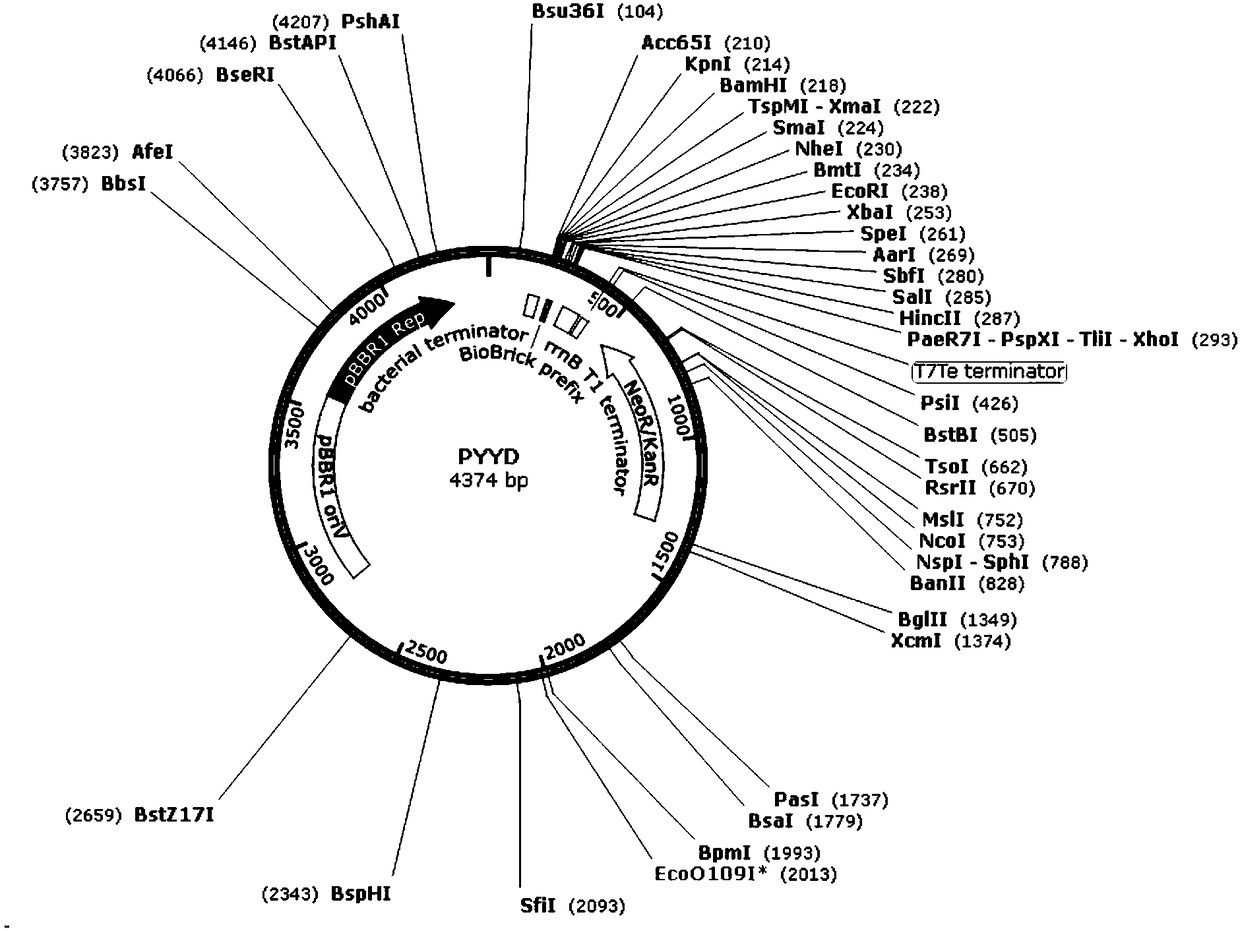Recombinant plasmid, recombinant shewanella and electricity generation method of microbial fuel cell (MFC)
A technology for recombinant plasmids and Shewanella, applied in the direction of microorganism-based methods, biochemical equipment and methods, recombinant DNA technology, etc. Method limitations and other issues, to achieve the effect of increasing the thickness and anode bioload, increasing the electron transfer rate, and better transferring electrons
- Summary
- Abstract
- Description
- Claims
- Application Information
AI Technical Summary
Problems solved by technology
Method used
Image
Examples
Embodiment 1
[0056] Embodiment 1: Construction of the recombinant plasmid of the present invention
[0057] Synthesize the promoter ptac or ptet gene sequence, synthesize and optimize the flavins gene sequence ribA, ribD, ribE, ribH, ribC (the gene is derived from Bacillus subtilis with RBS1);
[0058] Use the restriction site of PYYD (such as EcoRI, XbaI, SpeI, SdaI, two restriction sites of XbaI and SpeI are selected in this embodiment) and the bio-brick method to connect the ptac or ptet promoter and each flavins synthetic gene to the vector On PYYD, the recombinant plasmids (without the OprF gene) were obtained and named 3C5 (Ptac-ribADEHC-PYYD) and CT5 (Ptet-ribADEHC-PYYD) respectively. See the schematic diagram figure 2 (The arrow in the figure indicates the promoter).
[0059] Synthetic porin gene sequence OprF (gene derived from Pseudomonas aeruginosa, with RBS2), using the enzyme cutting site of PYYD (such as EcoRI, XbaI, SpeI, SdaI, the present embodiment selects two enzyme cut...
Embodiment 2
[0060] Embodiment 2: Adaptation comparison of different promoters and Shewanella
[0061] Synthesize the promoter gene sequence (pbad, ptac, ptet, LacUV5, T7, parcA), and use the four enzyme cutting sites (EcoRI, XbaI, SpeI, SdaI) of the biobrick to connect the promoter and the GFP gene (with RBS1) respectively On the vector PYYD, the plasmids Pbad-GFP-PYYD, Ptac-GFP-PYYD, Ptet-GFP-PYYD, LacUV5-GFP-PYYD, T7-GFP-PYYD, and ParcA-GFP-PYYD were obtained respectively. See the schematic diagram Figure 4 .
[0062] The Pbad sequence is shown in SEQ ID NO:12, the LacUV5 sequence is shown in SEQ ID NO:13, the T7 sequence is shown in SEQ ID NO:14, and the parcA sequence is shown in SEQ ID NO:13.
[0063] After ligation, each plasmid was introduced into Escherichia coli W3064 competent, and then combined with wild Shewanella MR-1 for transfer, and the constructed plasmid was transferred to Shewanella (transformation method can refer to Yang Y, Ding Y, Hu Y, etal.Enhancing bidirectiona...
Embodiment 3
[0065] Embodiment 3: the construction of the recombinant Shewanella of the present invention
[0066] 3C5 (Ptac-ribADEHC-PYYD), CT5 (Ptet-ribADEHC-PYYD), CT5-31O-PYYD and 3C5-31O-PYYD constructed in Example 1 were introduced into W3064 competent, and then mixed with Shewanella MR-1 Or combine the transfer of Shewanella with deposit number CGMCCNo.15432, transfer the constructed plasmid to Shewanella, and obtain the recombinant Shewanella of the present invention.
PUM
 Login to View More
Login to View More Abstract
Description
Claims
Application Information
 Login to View More
Login to View More - R&D
- Intellectual Property
- Life Sciences
- Materials
- Tech Scout
- Unparalleled Data Quality
- Higher Quality Content
- 60% Fewer Hallucinations
Browse by: Latest US Patents, China's latest patents, Technical Efficacy Thesaurus, Application Domain, Technology Topic, Popular Technical Reports.
© 2025 PatSnap. All rights reserved.Legal|Privacy policy|Modern Slavery Act Transparency Statement|Sitemap|About US| Contact US: help@patsnap.com



